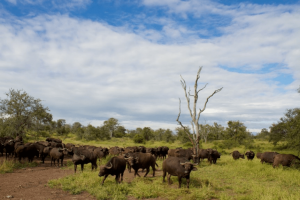 In Interview with Luke Bailes, Singita Owner and CEO
In Interview with Luke Bailes, Singita Owner and CEO
Travel can be a powerful catalyst to educate and protect natural and cultural heritage for future generations – which is part of the reason why The United Nations has declared 2017 the Year of Sustainable Tourism. As part of a year-long series, we’re interviewing experts and trendsetters in sustainable tourism. For this installment, we talk with Singita owner and CEO Luke Bailes. Renowned for its sustainable conservation, environmentally conscious operations, and community support, Singita operates 12 lodges and camps in three African countries. Talk about thought leadership: Bailes even has a 100-year plan for the company.
“Singita’s 100-year vision is to protect and preserve large areas of pristine wilderness for future generations,” he says. “With the continent’s precious wilderness areas and most vulnerable species under severe threat, Singita’s total dedication to conservation is important now, more than ever.”
What is the smartest trend in luxury safari travel right now?
There is a heightened awareness of the plight of wilderness and wildlife in Africa. Individuals are committing resources to be part of the solution and solve these challenges – not just financially, but to raise awareness on a broader level.
Before, travelers wanted to be disconnected from the wild and not too close to nature. But now, they want to feel connected to the earth. They are more aware of threats to the environment, and they want the most authentic experiences. That’s why Singita’s Mara River Tented Camp and Explore are popular: off-the-grid and close to nature.
What are you most nervous about when it comes to tourism in Africa?
Population growth – because of it, pristine wilderness areas are diminishing. Also, the mass slaughter of some animal species such as rhino and elephant.
How do you believe Africa’s exploding population will affect tourism and the continent as a whole?
The world’s resources are under increasing pressure – degradation of habitat which has a negative impact on many species – as populations increase. The situation in Africa is dire due to this population pressure and is placing wildlife and land at risk. We have recognized the need to elevate our conservation message – it is more relevant now than ever before. Tourism plays an important role in creating awareness.
What destination in Africa is on your radar?
Definitely the circuit between the gorillas in Rwanda and the Serengeti and the ability to experience that in one trip.
 Singita’s conservation efforts are vast and admirable – including projects and commitments in Kruger, Sabi Sand, the Serengeti, and Pamushana. What are the three most effective things Singita does to ensure the future of the African landscape?
Singita’s conservation efforts are vast and admirable – including projects and commitments in Kruger, Sabi Sand, the Serengeti, and Pamushana. What are the three most effective things Singita does to ensure the future of the African landscape?
Manage and protect the ecosystems and wildlife under our care – it is what travelers come to see.
Minimize the impact of our tourism on the ecosystems where we operate.
Provide economic opportunities and support to the communities around our reserves so that they benefit from, and support, the wildlife-based, land-use that we promote.
You have 12 properties across South Africa, Zimbabwe, and Tanzania. What attracts you to each region?
We have 12 unique lodges that offer something for everyone, across five different ecosystems in Africa. The wide open plains of the Serengeti allow for beautiful viewing of large herds of game, while the lush bushveld of the Sabi Sand and Kruger National Park create adventure around every corner with surprise viewings of elephants and cats. One of the most dramatic settings is Singita Pamushana: the majestic baobabs, mopane forests and sandstone outcrops take my breath away every time.
Interviewed by Annie Fitzsimmons for Virtuoso. Original article can be found here. You can read more about Singita here.


